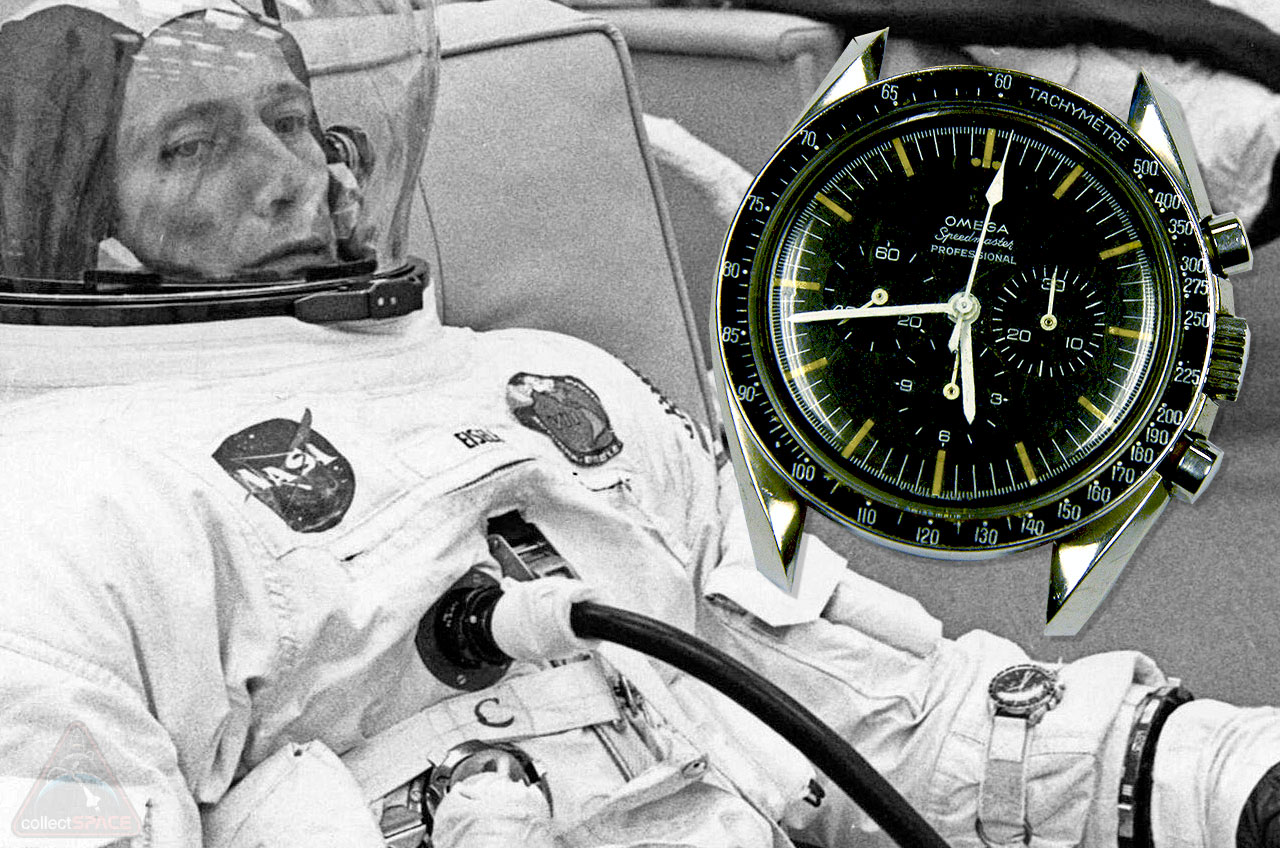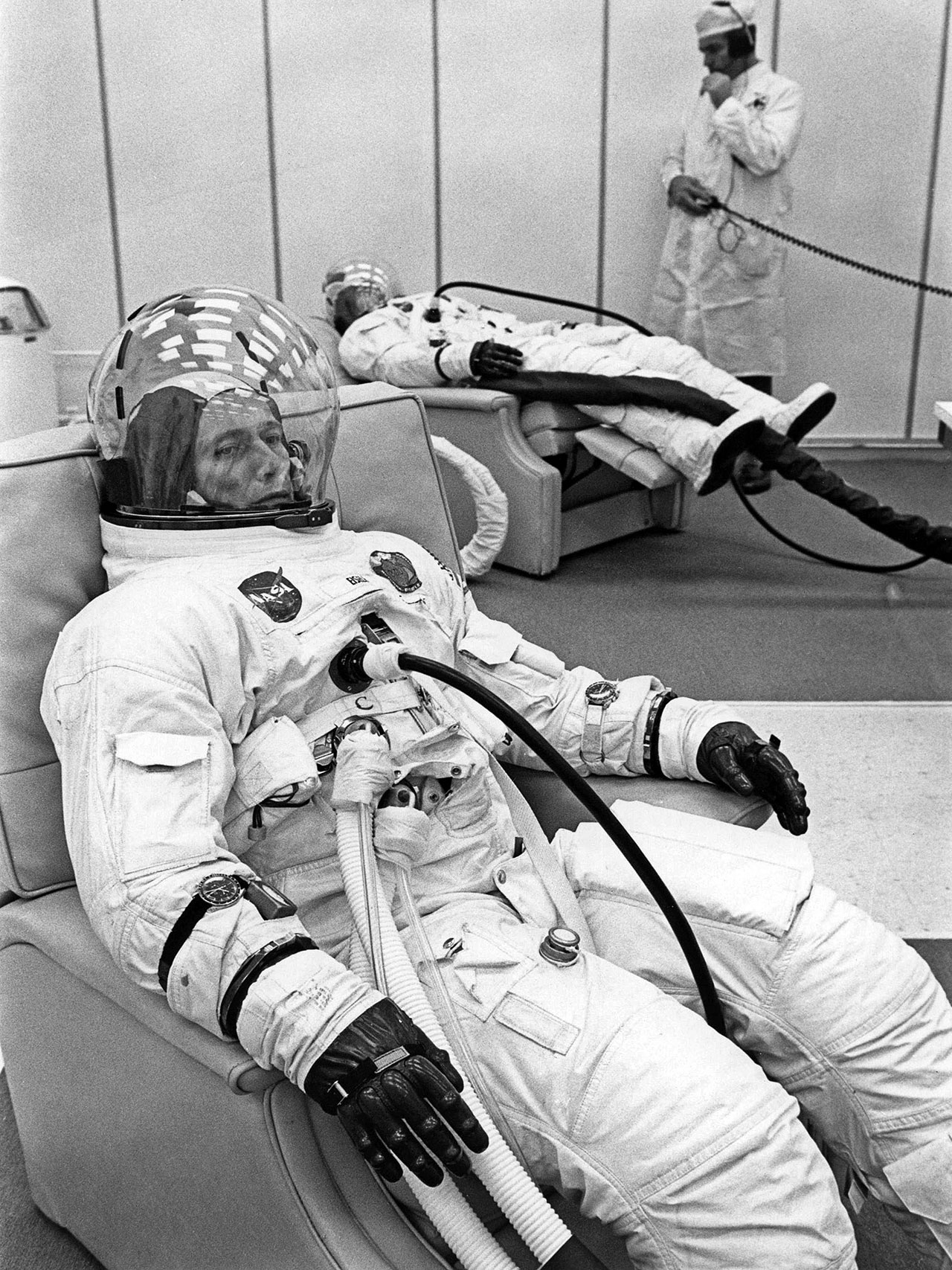Apollo Astronaut Watch, Stolen in Ecuador, Recovered 30 Years Later

A NASA astronaut's wristwatch worn aboard the first Apollo mission in 1968 has been returned to the Smithsonian, nearly three decades after it was stolen from a museum in Ecuador.
The Omega Speedmaster Professional chronograph, which astronaut Donn Eisele was issued to wear on board the Apollo 7 mission into Earth orbit, is now back in the custody of the Smithsonian's National Air and Space Museum. The watch was recovered with the help of space history enthusiasts, who provided the authorities with information about the chronograph's status and location.
Disclosure: As detailed below, collectSPACE editor Robert Pearlman was among the individuals who provided information that led to the watch being recovered. [Space and Time Collide in New Space Watches]
Eisele's NASA-issued Omega Speedmaster was on loan from the Smithsonian to the Instituto Geográfico Militar in Quito, Ecuador, when in 1989 it was stolen from its display. The local police investigated the theft, but a culprit was never identified.
The watch remained missing for 28 years. It briefly surfaced earlier this year at a watch show in Florida, but traces of it were quickly lost. Then, a person claiming to have been offered the watch for sale began reaching out for more details about its history.
From Earth orbit to Ecuador
"Someone tried selling me a vintage Omega Speedmaster with astronaut number [sic] engraved in the back and s/n [serial number] 34. I was afraid to buy, since I thought it might be fake. Do you have an idea what mission it was?" read an email sent to collectSPACE on the evening of Sept. 29.
Donn Eisele, who died in 1987 at age 57, launched on his first and only spaceflight as command module pilot on Apollo 7, the first mission of the U.S. moon landing program. The 10 day and 20 hour flight saw Eisele and his two crewmates, Wally Schirra and Walt Cunningham, put the Apollo command module through its paces while orbiting Earth 163 times from Oct. 11 to Oct. 22, 1968.
Get the Space.com Newsletter
Breaking space news, the latest updates on rocket launches, skywatching events and more!
Recognizing that its astronauts would need a chronograph to time mission events in space, NASA tested and selected the Omega Speedmaster as its flight-qualified watch beginning with the Gemini program. As the first Apollo crew to fly in space, Schirra, Cunningham and Eisele were each issued Speedmaster watches to wear with their spacesuits and other mission attire.
NASA engraved each Speedmaster with part and serial numbers, to help track its mission equipment. Eisele's NASA-issued chronograph was inscribed with the part number common to other NASA Speedmaster watches, SEB12100039-002, and a unique serial number, "34."
(Eisele also wore a personal Omega Speedmaster on Apollo 7, engraved with the serial number 38. That chronograph was sold by Sotheby's in 2007 for $204,000.)
In 1977, after the end of the Apollo program, NASA transferred the title for all of its Gemini and Apollo-flown Speedmasters to the Smithsonian. Initially, the museum offered the watches for loan back to the astronauts who had used them in space, but within a decade decided against the practice and refocused the loans to other museums.
The Instituto Geográfico Militar requested the loan of space artifacts, including a chronograph, in the mid-1980s, and was provided Eisele's Apollo 7 Speedmaster. [Gallery: Smithsonian National Air and Space Museum]

Serendipitous discovery
Five months ago, after hearing nothing about the Eisele watch for almost 30 years, the Smithsonian was alerted the chronograph was seen at a watch show. But prior to investigators being able to take action, it disappeared again.
Then in September, a space history and watch enthusiast signed onto eBay.
Garron DuPree, the bass guitarist for the coincidentally-named band Eisley, came across a watch seller from Texas who, after discussing various timepieces, shared the story of a friend who had bought a "vintage Omega Speedmaster with some very interesting engravings" for $5,000 while on a trip to Ecuador. The dealer said the watch was not for sale, but volunteered to share photos of it with DuPree.
"Shocked by what I was seeing while simultaneously being an extreme skeptic, I began furiously researching the subject," DuPree said in an email to collectSPACE after the Eisele watch was recovered. "It wasn't until I found information posted on collectSPACE that my suspicions began to be confirmed."
Concerned the chronograph could again disappear, DuPree held back details from the dealer, but reached out to collectSPACE for help contacting the authorities. At just about the same time, the eBay seller emailed collectSPACE with photos of the Speedmaster, seeking to authenticate the watch.
"I saw the watch in Mexico City and the owner is a [sic] worried he could have it taken away. He knew there was something special about it which is why he bought it. Weird situation," the man wrote.
collectSPACE and DuPree contacted the Smithsonian Office of Inspector General (OIG), the independent entity within the institution that oversees investigations into theft and fraud. Through the information that was shared, the OIG, working with the FBI, was able to identify the eBay dealer and confirm he was not in possession of the watch.
Within days of that happening though, another unidentified individual surrendered the watch to the FBI in Houston, Texas. The Eisele Speedmaster was then briefly held at the bureau's McAllen, Texas office, until its return to the Smithsonian.
Citing internal polices, the Smithsonian, OIG and FBI declined to comment for this article.
Back where it belongs
With the Eisele Speedmaster now back in the hands of the Smithsonian, it will, at least initially, be cared for at the Buehler Conservation Laboratory at the National Air and Space Museum Steven F. Udvar-Hazy Center in northern Virginia. Omega technicians periodically visit the lab to help inspect the NASA chronographs in the Smithsonian collection.
The Smithsonian is now missing only five Omega Speedmasters (out of the more than 50 transferred by NASA) that were stolen while on loan to other museums in the 1990s. There are also a few other flown watches that went missing outside of museums; most famously, the first watch worn on the surface of the moon, Buzz Aldrin's Apollo 11 Speedmaster, went missing while in transit to the Smithsonian in 1970.
DuPree expressed his pride in having contributed to returning a chronograph to its rightful place.
"To have played any part in the recovery of this priceless piece of history is among the most humbling privileges I have experienced," he said.
Kristy Eisele, the astronaut's daughter, told collectSPACE that she too was happy with the outcome.
"Through some kind souls and great detective work, my father's watch has been recovered," she said on Wednesday (Nov. 15). "I'm absolutely thrilled that it's back at the Smithsonian where it belongs."
See more photographs of Donn Eisele's Apollo 7 Omega Speedmaster chronograph at collectSPACE.
Follow collectSPACE.com on Facebook and on Twitter at @collectSPACE. Copyright 2017 collectSPACE.com. All rights reserved.
Join our Space Forums to keep talking space on the latest missions, night sky and more! And if you have a news tip, correction or comment, let us know at: community@space.com.

Robert Pearlman is a space historian, journalist and the founder and editor of collectSPACE.com, a daily news publication and community devoted to space history with a particular focus on how and where space exploration intersects with pop culture. Pearlman is also a contributing writer for Space.com and co-author of "Space Stations: The Art, Science, and Reality of Working in Space” published by Smithsonian Books in 2018.In 2009, he was inducted into the U.S. Space Camp Hall of Fame in Huntsville, Alabama. In 2021, he was honored by the American Astronautical Society with the Ordway Award for Sustained Excellence in Spaceflight History. In 2023, the National Space Club Florida Committee recognized Pearlman with the Kolcum News and Communications Award for excellence in telling the space story along the Space Coast and throughout the world.










